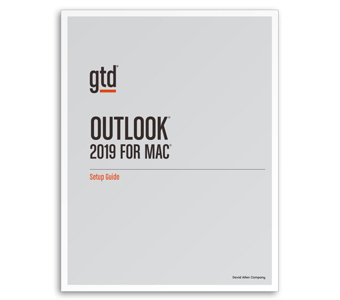David Allen's Blog, page 34
August 8, 2019
Peter’s GTD Story
Note: Peter’s GTD story is in a different format. Rather than the Q&A of recent installments, Peter’s story is an email he sent to David Allen. In it, he describes how he came across GTD, what tools he has used, and the positive impact it has had on his life.
Dear David,
I have had this on my Someday/Maybe list for at least a year, and now I’ve finally snuck a moment to write to you. I want to say, as strongly and fully as I can, thank you! What you have given me, and so many others, with GTD has been utterly life-changing and eye-opening.
In the interests of making it easy for you to process your email: The following is my story of coming to use and champion GTD, as well as an attempt to unequivocally make it known to you that you can count on me, as a devoted convert, to do whatever I can to help spread GTD from my current circumstances in the UK. So, from my point of view, I’m not presuming any next action on your part, but if you want to read this it will take more than 2 minutes. 
Episode #51: The Ultimate GTD App – Part One
At the June 2019 GTD Summit, David Allen briefly shared a vision of the ultimate GTD app, which consists of 19 pages of hand-drawn drafts of the screens he would want to use. To expand on that topic, we recorded David talking with Eric Mack and John Forrister about the past, present, and future of GTD software. It’s a wide-ranging discussion with stories that will inform, entertain, and maybe even surprise you. This episode is part one of two.
Subscribe or Download to GTD Podcasts
iTunes
Stitcher
Libsyn
Google Play Music
Spotify
SoundCloud
The post Episode #51: The Ultimate GTD App – Part One appeared first on Getting Things Done®.
July 3, 2019
David Allen on the Best Software for GTD

Hi Folks,
This post is for any of you who have ever asked, “What’s the best software tool with which to do GTD?”
I’m still buzzing myself from the recent global GTD Summit in Amsterdam. So many people from around the world; so much positive, supportive energy from everyone to anyone engaged. Wow. Quite a unique experience for me, and from what I’ve heard from all involved.
One topic I wanted to address at the Summit was: “Where is the GTD app?” in terms of a software tool that really “did it” for me.
It hasn’t happened yet.
Ultimate GTD appAt the Summit I briefly shared a vision of the “ultimate GTD app” which consists of 19 pages of hand-drawn drafts of the screens I would want to use. I just said to myself, “Can I click F1 on my computer and get to a clear head?” I spent two days creating those screens. This was in 1994.
Since I drew these, we’ve invested in two serious attempts at producing a software product that would do it (or at least come close). Both ended in a “not yet” conclusion, after tremendous research in the tech and analysis of the market (one in the mid-1990s and the last in the mid-2010s.) Our partners in these enterprises were the best and brightest you could possibly gather to explore this. But the technology required to make some simple GTD practices happen, and the lack of awareness in the marketplace for such a tool, put a kibosh on both endeavors.
Download the screens I would want to useSo I promised our hundreds of people at the GTD Summit that I would make those screens available to the public. This was originally legally protected IP; but I decided to just make it “open source” now in case any of you out there could make it happen.
Here they are, below. Or download the PDF.
My CTO and great friend for many years, Eric Mack, came the closest to giving us something that built in some of the best practices. And he’s recently written about his experience and what it takes to build the ultimate GTD app.
He knows the methodology, in spades, and what has worked and not worked in trying to digitalize it. It required configuring the Lotus (IBM) Notes app we still use in our company, with some great features and abilities. (That’s still what I use to manage my action lists). Eric has said he’d be open to connect with any of you who want to know more about how this best-practice model can be digitalized. He’s at Eric.Mack@FasterAtWork.com.
All the best, to all of you.
—David Allen
This essay appeared in David Allen’s Productive Living Newsletter. Subscribe for free here .
The post David Allen on the Best Software for GTD appeared first on Getting Things Done®.
June 14, 2019
What Science Says About Stress, Cognition, and Clarity
 Your head is a terrible office.
Your head is a terrible office.Your mind evolved to do incredible stuff—like stay alive in the desert or jungle. In fact, you’re benefiting from its evolved capacities right now: without effort, you recognize patterns and store and retrieve information to make sense of the myriad inputs coming at you twenty-four seven. You can look around and think, “That’s a chair, that’s a computer, that’s a person,” instead of perceiving each as simply multifarious vibrations of light and sound. Computers can hardly do that, even today. Yet you go to the store to get lemons, and you come back with six things and no lemons. What happened? You tried to use your head as your office.
Recent cognitive science research shows that the number of things you can mentally prioritize, manage, retain, and recall is . . . (hold on) . . . four! If you park any more than that in your head, you will sub-optimize your cognitive functioning. You will be driven by whatever is latest and loudest—rather than by strategy, intuition, or objective assessment.
Exercising your cognitive muscle
Your brain utilizes something like a “cognitive muscle,” which has limited capabilities and with overuse or misuse can get exhausted and enervated, just like your physical muscles. Storing tasks in your mind instead of within a trusted system—an “external brain”—forces it to do work it’s not designed to do well and keeps it spinning about. That’s why you wake up at 3:00am thinking, “I need cat food,” or, “What about our order that hasn’t come?”
Thirty-five years ago, I discovered the value and impact of unloading the mind of all tasks, to-dos, projects, and plans when a mentor had me do a complete “Mind Sweep.” I’ve since spent many thousands of hours, one-on-one, with some of the best and brightest people you’d ever meet, walking them through a similar process. Without exception, they achieved through that exercise greater control and focus, and experienced a huge reduction in stress. Without exception.
In the last decade, scientists in the relatively new field of cognitive science have published research that validates this process. In early years, this practice was called “distributed cognition,” which basically means get stuff out of your head. Distribute your cognitive load not only to relieve yourself of all that stressful remembering and recalling, but also so you can experience the joy of thinking creatively and solving problems, as your brain is optimized to do.
Resources for learning more
If you are interested in digging deeper into what science has concluded in this arena, here are four of my favorite recently published books, written by folks more expert than me in the field. (They all happen to be fans of GTD, by the way.)
Willpower: Rediscovering the Greatest Human Strength, by Dr. Roy Baumeister and John Tierney
Brain Chains: Your Thinking Brain Explained in Simple Terms, by Dr. Theo Compernolle
The Organized Mind: Thinking Straight in the Age of Information Overload, by Dr. Daniel Levitin
The Checklist Manifesto: How to Get Things Right, by Dr. Atul Gawande
Whether or not you believe what science says about the value of emptying the contents of your mind into some trusted bucket, try it out. I invite you to prove it wrong, as soon as you can, so you can at least get this off your mind!
—David Allen
This essay appeared in David Allen’s Productive Living Newsletter. Subscribe for free here .
The post What Science Says About Stress, Cognition, and Clarity appeared first on Getting Things Done®.
June 13, 2019
Komal Thakkar’s GTD Story
Tell us a little about yourself:
Komal Thakkar from Australia.
What do you do for work?
am the Founder, Managing Director for Productivity First and a Certified GTD Coach. My company, Productivity First, is a certified partner of David Allen Company in Australia.
How long have you been practicing GTD, how did you hear about it, which tools do you use, etc.?
I have practiced GTD for over 15 years.
I was gifted a small iPod® with the GTD Audio book by my brother-in-law at a time when I was out of control due to young kids, juggling work and life! My eldest son was 5 at the time, he is 20 now! I am forever thankful to Raj for this gift and indebted to David for creating this methodology.
I have been certified to teach GTD since early 2015 and enjoy the opportunity to spread GTD all over Australia via coaching and training teams and individuals.
Until recently Wunderlist® had been my choice of list manager for my GTD lists. I have moved to using Outlook® tasks and Microsoft® To-Do for my GTD lists since start of the year. My family and I still use Wunderlist for sharing shopping lists, medical histories, etc.
OneNote® is my preferred tool for storing reference materials and checklists.
After helping hundreds of clients in using a variety of list managers, I can tell you that the best tool is the one you are comfortable with.
How has GTD made a difference in your work and life?
GTD has created a balance in my life to an extent that I am unable to imagine life without GTD now! It is completely integrated with my life and allows me to be present in whatever I am doing and have a quality time with my family.
As a GTD Coach and Trainer, I have been fortunate to have worked with people at different professional levels ranging from Board Directors, C-level Executives, Department Heads, Managers all the way to new hires in a number of industries such as Healthcare, Education, Government, Legal, Construction and Financial Services. Such a diversity in GTD clientele keeps my work interesting and exciting! GTD helps me navigate all this and stay on top of it. I love my work:)
What areas of GTD are you doing really well (or at least better than you used to)?
David Allen Academy’s continuing education program helps me get deeper levels of this methodology. One thing I have noticed is that I have got really good at the ability to recalibrate fast and turn a messy day into a productive one. I can be productive even on days when I am having low cognitive energy.
I would say that I am also having a lot of fun with my someday maybe list!!
What areas of GTD would you like to get even better at doing?
Path of GTD mastery never ends – I am currently working on my Horizon 4: Vision and Horizon 5: Purpose and Principles.
What is one piece of advice you would give to someone just starting out with GTD?
Start with whichever part of GTD you are comfortable with. This could be the capturing or the 2-minute rule. In the long term, however, you want to be addicted to an empty intray/inbox and the weekly reviews; and of course, addicted to having the cognitive space as you are capturing everything that has your attention.
Give yourself time to get better at GTD. Go back to the basics whenever you fall off the GTD wagon, as it will happen at some point. Start by capturing and follow through with the five steps.
The post Komal Thakkar’s GTD Story appeared first on Getting Things Done®.
May 30, 2019
GTD and Outlook for Mac 2019 Setup Guide
 It’s here! We’re happy to announce our new best-practices guide for implementing GTD® with Microsoft Outlook® for Mac 2019.
It’s here! We’re happy to announce our new best-practices guide for implementing GTD® with Microsoft Outlook® for Mac 2019.
This Guide will show you how to:
– Understand the fundamental GTD best practices
– Optimally configure Outlook® for Mac 2019 in the way we have found works best for GTD
– Set up Outlook Tasks for your Projects and Actions
– Use the Calendar as a critical foundation for actions
– Get email to zero
– Create useful reference lists in Notes
Not an Outlook for Mac user? Check out our full library of expert GTD software guides.
The post GTD and Outlook for Mac 2019 Setup Guide appeared first on Getting Things Done®.
GTD® and Outlook® for Mac 2019 Setup Guide
 It’s here! We’re happy to announce our new best-practices guide for implementing GTD with Microsoft Outlook for Mac 2019.®
It’s here! We’re happy to announce our new best-practices guide for implementing GTD with Microsoft Outlook for Mac 2019.®
This Guide will show you how to:
– Understand the fundamental GTD best practices
– Optimally configure Outlook for Mac 2019 in the way we have found works best for GTD
– Set up Outlook Tasks for your Projects and Actions
– Use the Calendar as a critical foundation for actions
– Get email to zero
– Create useful reference lists in Notes
Not an Outlook for Mac user? Check out our full library of expert GTD software guides.
The post GTD® and Outlook® for Mac 2019 Setup Guide appeared first on Getting Things Done®.
May 21, 2019
10 Reasons GTD is Like Karate
For years I have woven the martial arts metaphor in and through my writing, training and coaching about the Getting Things Done® methodology. I had the  good fortune to be able to study karate for several years in my twenties, and my familiarity with that field gave me a rich context of images and concepts to draw from.
good fortune to be able to study karate for several years in my twenties, and my familiarity with that field gave me a rich context of images and concepts to draw from.
I didn’t fully appreciate, however, much of what getting my black belt gave me until later in life. Over the years I began to recognize the value of various habits and standards that training had ingrained in my personal style. They affected my approach to everything. And as I delved progressively deeper into the arena of personal productivity, similarities with karate began to resonate in many new ways. My conclusion was, and still is, that work (and life) IS a martial art—not just a reflection of it.
Though there is likely an infinite list of the similarities, the ones I find most interesting are the process replications—what’s the same in the nature of the two arts themselves.
Here are 10 reasons GTD is like karate:
1. There are no beginner’s moves.
You begin in karate learning moves that you will practice as a third-degree black belt. A roundhouse kick or knife-hand block is the same, whether you are just learning it or you are a sensei. Being responsible for your internal commitments, deciding what next physical action is required on something you want to do or change, clarifying your intention and vision—those are true from beginning to end, no matter how mature you are in life or its process. There’s no elementary way to process your inbox to zero.
2. It feels counter-intuitive and unnatural when you start.
Trying to stand and move gracefully in a karate “front stance” feels initially like one of the more unnatural things the body has ever attempted. It’s almost as weird as writing everything down that you commit to do something about, as it occurs to you. Or spending valuable time cleaning up non-critical open loops on the front end. Weird science.
3. Once you’re used to it, it is the most natural way to move.
Once you master the basic karate stances, your natural walk takes on a gracefulness you wonder why you ever did without. Once you integrate outcome- and next-action thinking into your life, not doing it seems both awkward and backward.
4. It handles basic movement and resource allocation masterfully.
In order to be able to break bricks with your hand and manifest a pinpoint of power in an instant, you learn to move the whole body with extreme efficiency. And once you’ve mastered the five steps of workflow, you don’t complain about your volume of e-mail nor mind putting everything on hold to focus on the surprise that just showed up.
5. It supports a peaceful and spontaneous way to move through the world, with minimal effort.
Once you’ve mastered the fighting arts, engaging in conflict per se becomes unnecessary and hard edges, rules, and structured defenses are much less required. With GTD maturity, a relaxed intuitive focus about what to do, when—unhindered by preconceptions and constraints—becomes the standard rhythm. Easy becomes the way to do hard things.
6. We don’t seem to be born knowing or doing it. (Or if we are, we unlearn it very fast.)
Nobody I’ve met seemed to grow up naturally efficient in how they move and generate speed and power. How many of you, in your first job, automatically asked, “What are we trying to accomplish here?” or, “What’s the next action? (And who’s doing it?)”
7. It can be learned.
Though we don’t seem to naturally inherit high performance motion, it can be learned. Everyone can certainly get better at it, if they can move at all. Everyone can learn how to better capture, decide about, organize, and review the results of their thinking.
8. It can be taught.
I’ve watched people learn both karate and GTD and demonstrate that they “get” it.
9. It can be practiced.
The more you rehearse karate and GTD moves, the smoother, faster, and more elegant you become at the art.
10. There is no end to how good you can be at it.
The more I learned about both arts, the more I realized I didn’t know, and how much more there was to experience, learn, express, and do.
So what? There’s a world of difference available to be experienced in an infinite number of worlds—gardening, golf, dance, music, love, art, investing, sales, war, peace, kite-flying, dog training, child rearing, GTD. But these worlds do not disclose themselves uninvited. They wait for the initiate to ask, to care, to engage. None of these seems easy, self-evident, or natural, though, on the front end. They all have dragons (or angels) at the gate, making it oh-so-easy to be discouraged from going further. Perhaps the easy way is the hardest way, at first.
The post 10 Reasons GTD is Like Karate appeared first on Getting Things Done®.
May 15, 2019
Episode #50: David Allen Talks with Brian Robertson
This is a fascinating, wide-ranging conversation between David Allen and Brian Robertson. They discuss how we as humans relate to our own attention, and how the increasing complexity of our work environment has necessitated that we get stuff off our minds. They point out multiple common threads between Getting Things Done for individuals and Holacracy for organizations. They also consider what happens after your personal system and your organization’s system are on cruise control.
Subscribe or Download to GTD Podcasts
iTunes
Stitcher
Libsyn
Google Play Music
Spotify
SoundCloud
The post Episode #50: David Allen Talks with Brian Robertson appeared first on Getting Things Done®.
Episode #50: David Allen Talks with Brian Robertson
David Allen and Brian Robertson discuss how we as humans relate to our own attention, and how the increasing complexity of our work environment has necessitated that we get stuff off our minds. They point out multiple common threads between Getting Things Done for individuals and Holacracy® for organizations. They also consider what happens after your personal system and your organization’s system are on cruise control.
Subscribe or Download to GTD Podcasts
iTunes
Stitcher
Libsyn
Google Play Music
Spotify
SoundCloud
The post Episode #50: David Allen Talks with Brian Robertson appeared first on Getting Things Done®.
David Allen's Blog
- David Allen's profile
- 1484 followers




